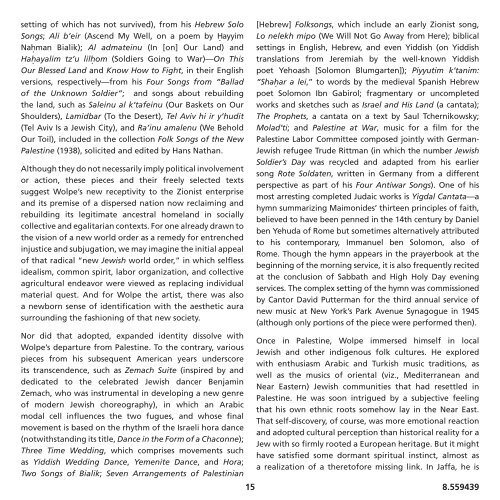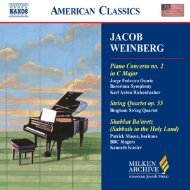Download Liner Notes PDF - Milken Archive of Jewish Music
Download Liner Notes PDF - Milken Archive of Jewish Music
Download Liner Notes PDF - Milken Archive of Jewish Music
You also want an ePaper? Increase the reach of your titles
YUMPU automatically turns print PDFs into web optimized ePapers that Google loves.
setting <strong>of</strong> which has not survived), from his Hebrew SoloSongs; Ali b’eir (Ascend My Well, on a poem by ḤayyimNaḥman Bialik); Al admateinu (In [on] Our Land) andHaḥayalim tz’u lilḥom (Soldiers Going to War)—On ThisOur Blessed Land and Know How to Fight, in their Englishversions, respectively—from his Four Songs from “Ballad<strong>of</strong> the Unknown Soldier”; and songs about rebuildingthe land, such as Saleinu al k’tafeinu (Our Baskets on OurShoulders), Lamidbar (To the Desert), Tel Aviv hi ir y’hudit(Tel Aviv Is a <strong>Jewish</strong> City), and Ra’inu amalenu (We BeholdOur Toil), included in the collection Folk Songs <strong>of</strong> the NewPalestine (1938), solicited and edited by Hans Nathan.Although they do not necessarily imply political involvementor action, these pieces and their freely selected textssuggest Wolpe’s new receptivity to the Zionist enterpriseand its premise <strong>of</strong> a dispersed nation now reclaiming andrebuilding its legitimate ancestral homeland in sociallycollective and egalitarian contexts. For one already drawn tothe vision <strong>of</strong> a new world order as a remedy for entrenchedinjustice and subjugation, we may imagine the initial appeal<strong>of</strong> that radical “new <strong>Jewish</strong> world order,” in which selflessidealism, common spirit, labor organization, and collectiveagricultural endeavor were viewed as replacing individualmaterial quest. And for Wolpe the artist, there was alsoa newborn sense <strong>of</strong> identification with the aesthetic aurasurrounding the fashioning <strong>of</strong> that new society.Nor did that adopted, expanded identity dissolve withWolpe’s departure from Palestine. To the contrary, variouspieces from his subsequent American years underscoreits transcendence, such as Zemach Suite (inspired by anddedicated to the celebrated <strong>Jewish</strong> dancer BenjaminZemach, who was instrumental in developing a new genre<strong>of</strong> modern <strong>Jewish</strong> choreography), in which an Arabicmodal cell influences the two fugues, and whose finalmovement is based on the rhythm <strong>of</strong> the Israeli hora dance(notwithstanding its title, Dance in the Form <strong>of</strong> a Chaconne);Three Time Wedding, which comprises movements suchas Yiddish Wedding Dance, Yemenite Dance, and Hora;Two Songs <strong>of</strong> Bialik; Seven Arrangements <strong>of</strong> Palestinian[Hebrew] Folksongs, which include an early Zionist song,Lo nelekh mipo (We Will Not Go Away from Here); biblicalsettings in English, Hebrew, and even Yiddish (on Yiddishtranslations from Jeremiah by the well-known Yiddishpoet Yehoash [Solomon Blumgarten]); Piyyutim k’tanim:“Shaḥar a lei,” to words by the medieval Spanish Hebrewpoet Solomon Ibn Gabirol; fragmentary or uncompletedworks and sketches such as Israel and His Land (a cantata);The Prophets, a cantata on a text by Saul Tchernikowsky;Molad’ti; and Palestine at War, music for a film for thePalestine Labor Committee composed jointly with German-<strong>Jewish</strong> refugee Trude Rittman (in which the number <strong>Jewish</strong>Soldier’s Day was recycled and adapted from his earliersong Rote Soldaten, written in Germany from a differentperspective as part <strong>of</strong> his Four Antiwar Songs). One <strong>of</strong> hismost arresting completed Judaic works is Yigdal Cantata—ahymn summarizing Maimonides’ thirteen principles <strong>of</strong> faith,believed to have been penned in the 14th century by Danielben Yehuda <strong>of</strong> Rome but sometimes alternatively attributedto his contemporary, Immanuel ben Solomon, also <strong>of</strong>Rome. Though the hymn appears in the prayerbook at thebeginning <strong>of</strong> the morning service, it is also frequently recitedat the conclusion <strong>of</strong> Sabbath and High Holy Day eveningservices. The complex setting <strong>of</strong> the hymn was commissionedby Cantor David Putterman for the third annual service <strong>of</strong>new music at New York’s Park Avenue Synagogue in 1945(although only portions <strong>of</strong> the piece were performed then).Once in Palestine, Wolpe immersed himself in local<strong>Jewish</strong> and other indigenous folk cultures. He exploredwith enthusiasm Arabic and Turkish music traditions, aswell as the musics <strong>of</strong> oriental (viz., Mediterranean andNear Eastern) <strong>Jewish</strong> communities that had resettled inPalestine. He was soon intrigued by a subjective feelingthat his own ethnic roots somehow lay in the Near East.That self-discovery, <strong>of</strong> course, was more emotional reactionand adopted cultural perception than historical reality for aJew with so firmly rooted a European heritage. But it mighthave satisfied some dormant spiritual instinct, almost asa realization <strong>of</strong> a theret<strong>of</strong>ore missing link. In Jaffa, he is15 8.559439
















